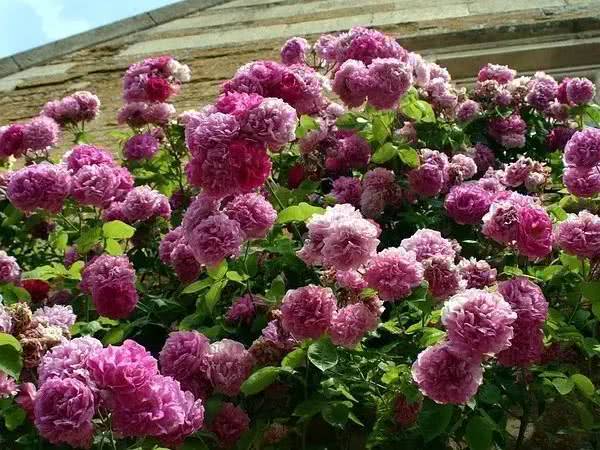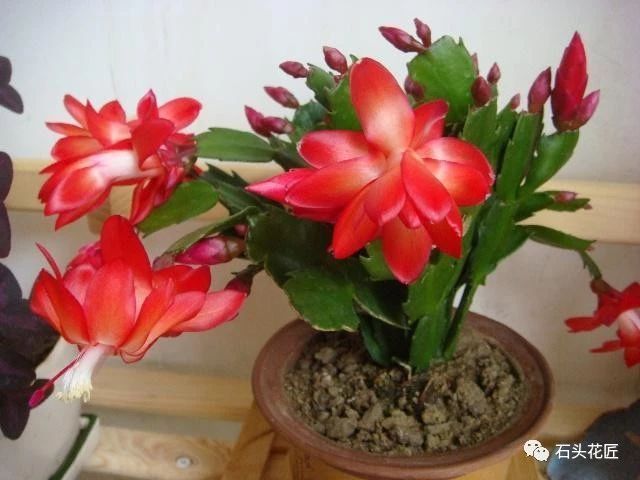Foolishly confused? Do you know the relatives of these plants?

Brain craftsmanship
You have 40 friends who follow the official account!
Tens of thousands of beautiful flowers, how many do you know? There are many "close relatives" in plants, the same beautiful extraordinary, but the subtle gap, but it is difficult to distinguish Oh!
1. Rose, Rose and Rose
These three names are the most troublesome because they all have both narrow and broad concepts.
First of all, in a narrow sense:
Rose generally refers to Rosa multiflora, which is called Baby Rose in English, including the original variety and various varieties such as Rosa farinosa, Seven Sisters, Bai Yutang and so on.
Seven sisters Seven Sisters
Rose refers to Rosa chinensis, known as China rose in English, and perfume rose (Rosa × odorata) (perfume rose is usually considered to be a hybrid of Rosa chinensis and Rosa gigantea), and Tea rose in English. But in fact, most of the popular roses are mixed-blood. In history, after the Chinese rose was introduced into Europe, the breeders hybridized it with roses from all over the world to get a wide variety of modern roses, while most of the roses cultivated in ancient China have been lost.
Several roses that were first introduced into Europe:
Monthly red Slater "s Crimson China
Moon powder Parsons "Pink China
Light yellow perfume Park "s Yellow Tea-Scented China
Rose refers to Rosa rugosa, which is called Japanese rose in English. Traditional rose tea, rose dew, rose cream and so on are made of this kind of flower. The rose mentioned by the cut flower is actually the perfume Hybrid Tea of the modern rose, and the real rose is not suitable to be a cut flower.
Rose Rosa rugosa
Double white rose Rosa rugosa f. Albo-plena
Let's talk about the broad sense:
All three can refer to all the plants of the genus Rosa, but it is customary that the rose refers to the small and climbing flowers, the rose refers to the large flowers and the four seasons bloom, and the rose refers to the edible ones.
two。 Don't forget the grass and the deep wave leaf buxue grass
The "forget-me-not" used in cut flowers is actually Limonium sinuatum, also known as star Chenhua, or Wavyleaf sea-lavender in English.
Herba Euphorbiae Limonium sinuatum
The forget-me-not in myths, legends and literary works is actually a plant of the genus Myosotis, which is called Forget-me-not in English.
Don't forget the grass Myosotis sylvatica
3. Daisies, Marguerite and Niuyan Chrysanthemum
Daisies are called Daisy in English, which can be divided into broad sense and narrow sense. Daisy refers to Compositae in broad sense and Bellis perennis in narrow sense, also known as longevity chrysanthemum.
Daisy Bellis perennis
Marguerite is called Marguerite in English and can usually refer to two kinds of plants: Leucanthemum vulgare, alias French chrysanthemum, and Argyranthemum frutescens, alias muchunchrysanthemum and chrysanthemum.
Binju Leucanthemum vulgare
Artemisia annua Argyranthemum frutescens
Cow eye chrysanthemum refers to the cow eye chrysanthemum (Buphthalmum salicifolium), which is called Yellow oxeye daisy in English. However, the English word oxeye daisy refers to Leucanthemum vulgare, so in some translations, "Niuyan Ju" may also refer to Binju.
Cow eye chrysanthemum Buphthalmum salicifolium
4. Mandala and Mandrake
Mandala generally refers to Datura stramonium and can also refer to Datura; it is also an alias for camellia. Mandala is related to Buddhist legends.
Mandala Datura stramonium
Mandrake refers to the genus Mandragora, which is called Mandrake in English. European legends refer to it as the plant that pulls up and screams.
Poisonous ginseng eggplant Mandragora officinarum
5. The Emerald Finch and the Sparrow Grass
Many people regard delphinium as a nickname for emerald finches, because both speak Larkspur in English. In fact, the two are different plants, even different genera.
Delphinium refers to the plant of the genus Siberian larkspur, especially Delphinium grandiflorum, which is called Siberian larkspur or Chinese larkspur in English.
Jade Finch Delphinium grandiflorum
Swallow refers to the genus Consolida, especially Consolida ajacis, which is called Rocket larkspur in English.
Swallow grass Consolida ajacis
6. Sycamore and French sycamore
Indus, also known as Firmiana simplex, originated in China.
Sycamore Firmiana simplex
French sycamore actually refers to two-ball Platanus hispanica (Platanus × Suzuki), the real name should be Yingtong, English London Plane. It is a tree species derived from the hybrid of one-ball Platanus tree (Platanus occidentalis), namely Meitong tree, and three-ball Platanus tree (Platanus orientalis). It is widely cultivated as a street tree in China, but it is easy to cause allergies in some people.
Platanus × hispanica of Platanus acerifolia
No matter it is one ball, two balls or three balls, Suzuki is not native to China, and the history of domestic cultivation is very short. How could the ancients write poems about it?
7. Locust tree and Robinia pseudoacacia
Styphnolobium japonicum, that is, Robinia pseudoacacia, originated in China.
Huai Styphnolobium japonicum
Robinia pseudoacacia, or Robinia pseudoacacia, is native to the United States.
Black locust Robinia pseudoacacia
8. Plum blossom and wax plum
Plum (Prunus mume) blossoms in early spring, with red, pink or white flowers.
Mei Prunus mume
Wax plum (Chimonanthus praecox), also known as wax plum, blossoms in winter with yellow flowers.
Chimonanthus Chimonanthus praecox
9. Begonia and begonia
Begonia refers to Malus spectabilis, which can also be used as a general name for some plants of the genus Malus and Chaenomeles. The more famous ones are four grades of begonia: Malus × micromalus, Malus halliana, Chaenomeles speciosa and Chaenomeles cathayensis.
Begonia Malus spectabilis
Xifu begonia Malus × micromalus
Begonia verticillata Malus halliana
Wrinkled papaya (Begonia campestris) Chaenomeles speciosa
Hairy leaf papaya (papaya begonia) Chaenomeles cathayensis
Begonia refers to the genus Begonia, especially begonia (Begonia grandis).
Begonia Begonia grandis
10. Papaya and papaya
Papaya refers to papaya (Chaenomeles sinensis), which can also be used as a general name for the genus Chaenomeles. The "papaya" sold on the market is actually papaya.
Papaya Chaenomeles sinensis flower
Papaya Chaenomeles sinensis fruit
Papaya (Carica papaya) originates from America and is shaped like papaya, so it is called papaya.
Papaya Carica papaya flower (male flower)
Papaya Carica papaya fruit
11. Grass hydrangea, wood hydrangea, hydrangea, powder ball and snowball
Another series of messy names.
Grass hydrangea (Cardiandra mollendorffii) is mostly wild in China, so it is rare at ordinary times.
Hydrangea Cardiandra mollendorffii
Wood hydrangea refers to Viburnum macrocephalum, and Qionghua is a variety of it. But some people mistook Hydrangea paniculata for wood hydrangea.
Hydrangea Viburnum macrocephalum
Hydrangea generally refers to Hydrangea macrophylla and can also refer to plants of the genus Hydrangea.
Hydrangea Hydrangea macrophylla
Vermicelli is the name taken by the ancients. It is considered to be Viburnum plicatum in Chinese Flora and Hydrangea paniculata in traditional Chinese medicine. Personally, I agree with the latter, because the infertile flowers turn red in late autumn, forming a large "powder ball".
Snowball pod Viburnum plicatum
Conical hydrangea Hydrangea paniculata
Snowball refers to Viburnum opulus. It is worth mentioning that the famous Russian songs "raspberry blossoms" and "raspberry blossoms" and "Kalinka" in Kalinka refer to snowballs.
European pod Viburnum opulus
Everything is wonderful, there is a praise mall in the flower school.
There are flowers and love, a school of flowers
- Prev

How many of the 6 anxiety symptoms do you have in life?
You have 40 friends following this public account! Have you ever encountered such a situation? When I went downstairs, I suddenly suspected that I hadn't locked the door. I rushed back to check and sent WeChat to others. I didn't receive a reply. I was worried that I had said something wrong...
- Next

In the pots of magnolia and crab claw orchids, some golden partners will burst and blossom during the Lunar New year.
Gentleman orchid, crab claw orchid pot to some flower "golden partner", the New year "burst pot" blossom! In the twinkling of an eye, it is the Beginning of Autumn, the temperature is gradually falling into autumn, and it is this season that flowers enter the golden stage of growth, especially.
Related
- Wuhan Hospital Iron Tree Blooming Result Was Instantly Frightened by the Gardener Master
- Which variety of camellia is the most fragrant and best? Which one do you like best?
- What is the small blue coat, the breeding methods and matters needing attention of the succulent plant
- Dormancy time and maintenance management of succulent plants during dormancy
- Minas succulent how to raise, Minas succulent plant pictures
- What are the varieties of winter succulent plants
- How to raise succulent plants in twelve rolls? let's take a look at some experience of breeding twelve rolls.
- Attention should be paid to water control for succulent plants during dormant period (winter and summer)
- Watering experience of twelve rolls of succulent plants
- Techniques for fertilizing succulent plants. An article will let you know how to fertilize succulent plants.

